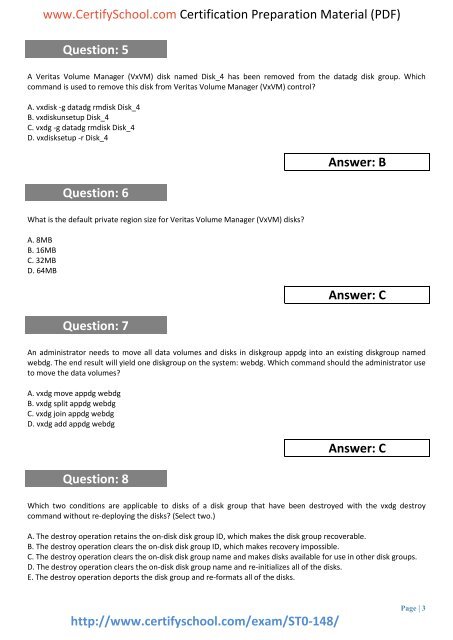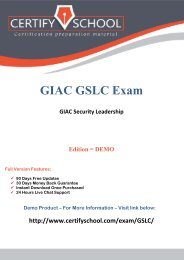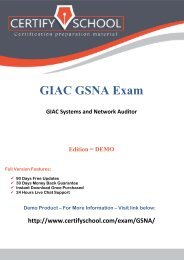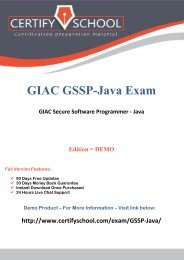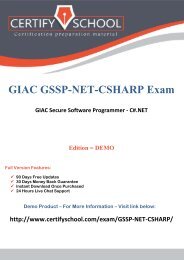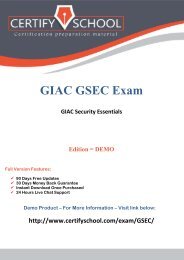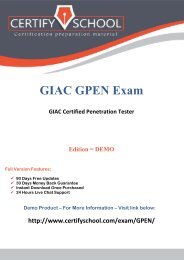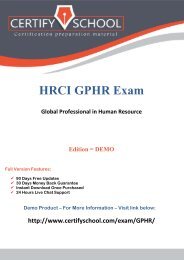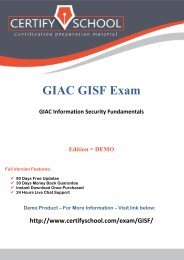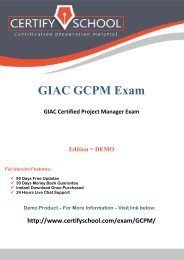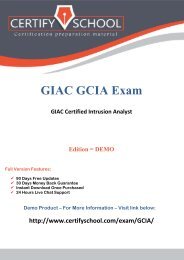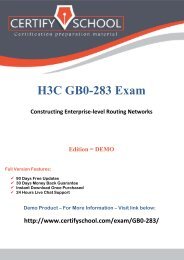Symantec ST0-148 CertifySchool Exam Actual Questions (PDF)
For more Full product Details:www.CertifySchool.com Our workable study material for exam meets the exact and accurate exam questions and answers. So that’s why CertifySchool is popular in the field of IT Certification Exams material providers.Please visit site: www.CertifySchool.com/
For more Full product Details:www.CertifySchool.com
Our workable study material for exam meets the exact and accurate exam questions and answers. So that’s why CertifySchool is popular in the field of IT Certification Exams material providers.Please visit site: www.CertifySchool.com/
You also want an ePaper? Increase the reach of your titles
YUMPU automatically turns print PDFs into web optimized ePapers that Google loves.
www.<strong>CertifySchool</strong>.com Certification Preparation Material (<strong>PDF</strong>)<br />
Question: 5<br />
A Veritas Volume Manager (VxVM) disk named Disk_4 has been removed from the datadg disk group. Which<br />
command is used to remove this disk from Veritas Volume Manager (VxVM) control<br />
A. vxdisk -g datadg rmdisk Disk_4<br />
B. vxdiskunsetup Disk_4<br />
C. vxdg -g datadg rmdisk Disk_4<br />
D. vxdisksetup -r Disk_4<br />
Question: 6<br />
Answer: B<br />
What is the default private region size for Veritas Volume Manager (VxVM) disks<br />
A. 8MB<br />
B. 16MB<br />
C. 32MB<br />
D. 64MB<br />
Question: 7<br />
Answer: C<br />
An administrator needs to move all data volumes and disks in diskgroup appdg into an existing diskgroup named<br />
webdg. The end result will yield one diskgroup on the system: webdg. Which command should the administrator use<br />
to move the data volumes<br />
A. vxdg move appdg webdg<br />
B. vxdg split appdg webdg<br />
C. vxdg join appdg webdg<br />
D. vxdg add appdg webdg<br />
Question: 8<br />
Answer: C<br />
Which two conditions are applicable to disks of a disk group that have been destroyed with the vxdg destroy<br />
command without re-deploying the disks (Select two.)<br />
A. The destroy operation retains the on-disk disk group ID, which makes the disk group recoverable.<br />
B. The destroy operation clears the on-disk disk group ID, which makes recovery impossible.<br />
C. The destroy operation clears the on-disk disk group name and makes disks available for use in other disk groups.<br />
D. The destroy operation clears the on-disk disk group name and re-initializes all of the disks.<br />
E. The destroy operation deports the disk group and re-formats all of the disks.<br />
http://www.certifyschool.com/exam/<strong>ST0</strong>-<strong>148</strong>/<br />
Page | 3


